To put it in perspective—Wimbledon isn’t just a tennis tournament, but really the epitome of English culture and history. Each year, tennis enthusiasts from all over the world eagerly descend upon the All England Lawn Tennis and Croquet Club in London to catch a glimpse of what is always one of this prestigious events. The turf at Wimbledon makes for an unpredictable playing surface and leads to some of the most intense matchups in sports, distinguishing it from hard courts used during the Australian Open or clay surfaces favored by its slab sibling across the channel on Roland Garros. Although Wimbledon is one of the four major tennis tournaments, recognized as a grand slam event, its status sets it completely apart from the fact that grass courts are used throughout play. Allegedly, the crown jewel of tennis according to the International Tennis Federation who is being participated in by hundreds and thousands of players and Serena Williams as a legend.
Wimbledon court type grass, notably Centre Court; the backdrop to tennis greatness. That makes for a game where players adjust to the quick movements on slick grass surfaces and fans see fantastic athleticism as well as skill. The tournament is synonymous with tradition, from strawberries and cream to the Royal Box. While the sport has evolved elsewhere, Wimbledon still represents the apex of what is possible on a well-groomed lawn over two weeks.
Centre Court: The Heart of Wimbledon
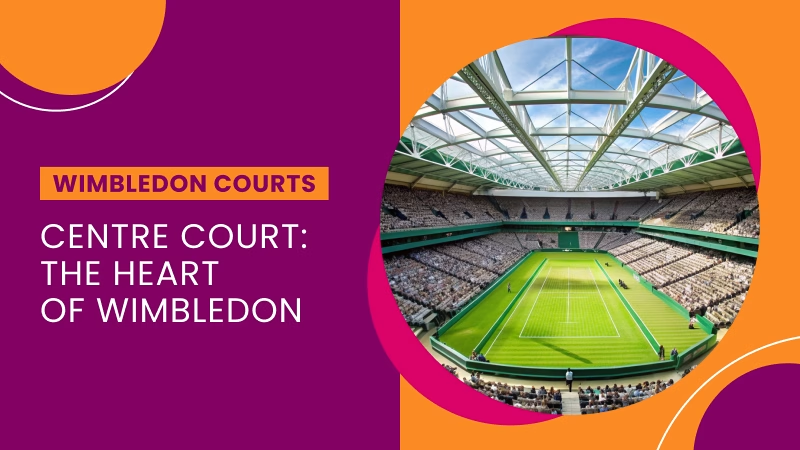
The Centre Court is where the cream of Wimbledon Championships takes place, hosting some crucial matches across generations. Little Room (Luxury Travel) A court, but also hallowed ground Little Room Video By LITTLE ROOM APRIL 1, 2018 The stands loom over the court at Louis Armstrong Stadium.
History and Significance
Centre Court, which was built in 1922 at the club’s location on Church Road -accommodates over, fans. In 1881, it was originally called Centre Court because of its location at the center of the AEC. It has been the symbol of tennis grandeur ever since. The tradition of Wimbledon is its source of pride, but it knows when to modernize as well, and Centre Court epitomizes this delicate process……and here is where the champions are born and legends made. Legends have ascended, champions been named on the court countless times through the years in what is one of sports’ most storied stages.
Game-Changing Retractable Roof
Wimbledon enhanced the experience in 2009 with a new retractable roof over Centre Court, thus providing a solution to one of the tournament’s most enduring problems: Britain’s capricious weather. Rain delays became a source of major frustration for both the players and fans as matches were constantly interrupted before the installation of it. The roof was a masterstroke, ensuring play could continue regardless of the weather. This innovation has also protected the integrity of grass courts and allowed for play on all tournament days, irrespective of rain.
Memorable Matches and Moments
Over the years, Centre Court has held many classic matches and moments that have enthralled tennis lovers around the world. Throughout all of this history, the court has also provided a playground for some of the most dramatic and thrilling encounters in sport — from Björn Borg versus John McEnroe’s legendary 1980 five-set final to Roger Federer against Rafael Nadal’s epic duel spanning two days in 2008. It’s where the domineering Serena Williams played, and Pete Sampras cemented his legend at. Centre Court is steeped in history, but every year new chapters unfold here…
No. 1 Court: A Venue of Upsets and Thrills
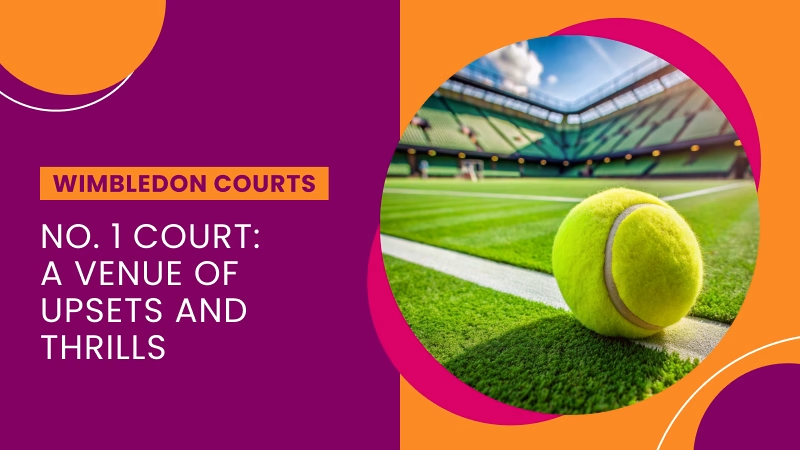
Another major attraction of Wimbledon is the No. 1 Court, which has seen some very interesting matches happen out there including huge upsets as well. But never short of anything in the drama stakes is a court.
History and Evolution
Court 1 has changed a lot over the years. Originally sited by Centre Court it was re-sited in 1997 to enable an increased capacity and contemporary facilities. Moving also allowed the All England Club to improve spectator viewing, ensuring No. 1 Court remains a top venue with Centre Court in terms of levels of comfort and views. The 2019 edition of the Championships also saw a retractable roof added to No. 1 Court, further strengthening its status by allowing matches to continue under cover even if rain or other bad weather were threatening postponement.
Notable Matches and Upsets
No 1 Court has seen some electrifying encounters and giant-killing acts. It is on this court that upstarts have pulled off the impossible, taking down superior ranked players in thrilling fashion. Fans remember with affection efforts such as Tim Henman and ‘never heard of’ players creating major upsets. No. 1 Court also has an unpredictable air about it that followers of local tennis like to refer to as a healthy dose of British misery, although neutral lovers believe the former sounds better and often use this fact for moral one upmanship at any given opportunity.
No. 2 Court: The “Graveyard of Champions”
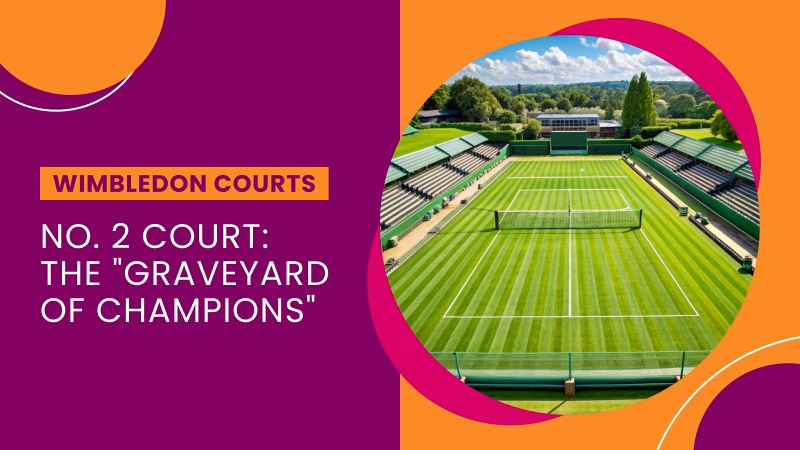
No 2 Court-vulgo the “fossa dei campioni” in ragione dell’alto numero di sorprese consumatesi sul suo rettangolo d’erba It is a court upon which champions have fallen and from it has risen new standouts.
Reputation for Upsets
Indeed, “Graveyard of Champions” has been used as a nickname because some high-level players have fallen on Court 2. Decades of high-ranking casualties on this court, many at the hands of non-seeded players It led to the court emerging as a cultural marvel with fans coming in droves just to catch potential upsets and record moments. It is where the unpredictable world of tennis makes perfect sense.
Famous Matches and Players
Court No. 2 has been the site of some unforgettable Wimbledon matches and moments…. You might recall it as the historic win of Lori McNeil over Steffi Graf In 1994, or perhaps you remember when an unknown Lukas Rosol defeated Rafael Nadal in a court shaking upset in 2012. These are all part of Wimbledon lore — more involving memories and gossip than reality, continuing a tradition that rolls from one generation to the next about how impossible Centre Court is. For the fans it is a chance to watch matches on No 2 Court, where they could witness that next big upset.
Wimbledon’s grass courts — Centre Court, No. 1 Court and No. 2 Court — are hallowed more than mere playing grounds but rather as the tournament’s soul and heritage. Every court has its own personality and tales which only adds to the magic of Wimbledon. From Centre Court to No. 2, these venues have hosted some of the greatest moments in tennis history. With the game changers still tinkering on their grass court concoctions, fans look forward to what Wimbledon has in store next. Be it a classic five-set thriller or an outrageous upset, Wimbledon always manages to raise the game of tennis by giving this sport great moments.
The Outer Courts: Where Legends Are Born

The most famous name in tennis is Wimbledon, and when you outwear it, while Centre Court or No. 1 quickly comes to mind, the real magic often takes place on far outer courts. Court 3 through Court 18, this is where the unknowns carve their path to immortality and tennis fans first lay eyes on future legends. There may be two main courts much more hallowed than the outer ones, but they are very much the heart of Wimbledon showing and making tennis’ future.
Overview of Courts 3-18
The outer courts at Wimbledon are some of the crucial parts of how a tournament like this looks. Most matches are also played on sunken grass courts (which participants forget after the first week) around the grounds of The All England Lawn Tennis and Croquet Club. With courtside seating on Courts 3-18, all the fun takes place right in front of your eyes!! Unlike Centre Court and No. 1 Court, which have retractable roofs to guard against rain showers that can fall out of the blue during long rallies across this open space in southwest London, play on these outer courts continues rain or shine – giving an added dimension to individual matches.
Every court has its different personality and appeal. Court 3 is generally seen as the premier court of the outer courts, and can often colloquially be referred to as “third stadium” after Centre Court and No. 1 Courtyard The other courts are a bit more intimate, giving fans the thrill of a firsthand view during early-round matches. This is the moment where many players start in Wimbledon Championships with visions to write their name on the tournament.
Young, Unlikely Heroes
The MotorCity Casino and Hotel welcomes new faces with open doors in the outer courts, where rising stars and surprising heroes serve as a stage. These are the very courts that draw those yearning to get a look at the next new thing in tennis each spring. The future celebrated Majors champion of today like Federer, Serena Williams and a number of other contemporary tennis legends all took their first steps in these little known courts before graduating to the grand stages that are main court actions.
The courts are also popular for causing quick and dramatic upsets or matches. With far less pressure as well lower set of eyes reporting in relation to the main courts; players often walked out onto these courts with their veins opened and performed historically. This history created a stage where it is very common for an unseeded player to beat the top-ranked players and become surprise heroes in one of their biggest tournaments.
The outer courts on those first days serve as both proving grounds and obstacles to the players. The ball moves differently to on the grass; smaller crowds provide a more intense atmosphere that adds excitement during matches. The next generation of tennis stars are forged on these courts and they form an integral part in the larger Storyline that is the Wimbledon Championships.
The Grass Courts of Wimbledon: A Unique Surface
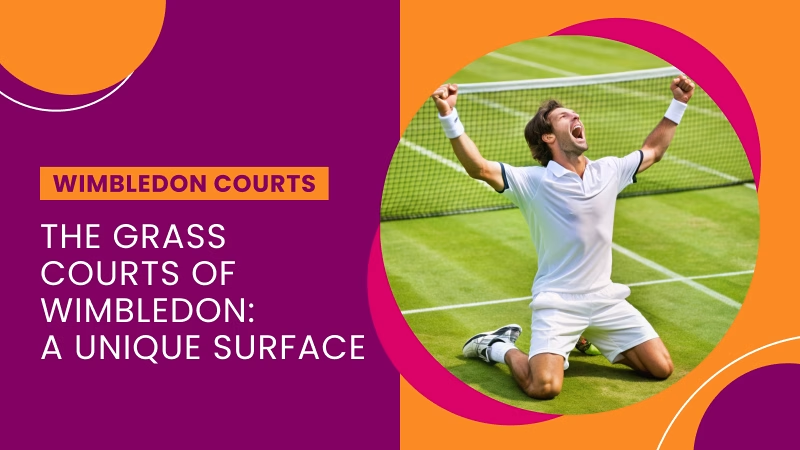
Unlike both the Australian and French Open, Wimbledon features some grass courts which naturally create a much different game compared to those that are played on hard court surfaces. The singles grass court at Wimbledon produces a unique experience, examining even the most experienced of players with an intricate free-for-all in strategy. Wimbledon is the only tournament that takes place on grass and conditions are hugely different to what they are used to, where play can be lightning quick on these fast-slick grass surfaces.
The 100% Perennial Ryegrass
Wimbledon is known for the quality of its grass courts, which are meticulously looked after in order to provide a consistent bounce and speed. It is 100% perennial ryegrass, providing a surface that will be incredibly durable and playable over the week. This grass offers a level surface, something quintessential for the quick on-court style of playing that is enshrined at Wimbledon.
The courts are made up of perennial ryegrass which enhances their durability, making them well-suited for daily use as well as the hits and rains from English weather. Stringent care is taken in selecting and growing the grass to ensure that its quality remains at its peak level so as to provide a great surface of play, always befitting for world-class players. A grass court is used at WimbledonCredit: PA; This surface is in stark contrast to the other three grand slam tournaments and provides a unique challenge for players.
Exhaustive maintenance & setup
Wimbledon’s preparation of grass courts continues throughout the year. The grounds team at the All England Lawn Tennis and Croquet Club, AELTC to its friends, put in loads of work to make sure that facilities are immaculate for The Championships. The grass is trimmed to a precise 8mm height, courts are rolled and marked exactly so as to deliver an unwavering playing session.
In the weeks just before The Championships begin, a lot of work goes into making sure that these hallowed courts are competition-ready for tennis’ most famous fortnight. There is always someone keeping a close eye on the maintenance of it so as to keep up with the best practices. The courts are also coated to be injury-preventive, as well as fortified with Armortec which hardens the course for more durability and longer life; all of these helps in making it able to withstand competitive play.
The effect of grass on gameplay
Unlike other surfaces at Wimbledon, the grass surface has a more massive implication on how tennis is to be played. Grass: Grass courts are fast and low-bouncing, which provides an advantage to serve-volley players. Due to the skid( lower bounce) of ball(bouncy) on grass courts players have changed their playing strategies and tactics compared with other surfaces like clay court or hardcourts.
Good footwork and an attacking style of tennis are usually the hallmarks of a player who can play well on grass. Its quick surface rewards players who can get ahead in points and end rallies quickly. At the same time, grass also provides difficulty in movement since it can be slippery. Movement is key to playing on this surface, players have to move fast and change directions quickly
Wimbledon’s grass courts are one of the toughest challenges in tennis, and even the top players on tour must adapt. It is a very difficult tournament to win, as the surface requires an unusual combination of power and finesse and tactical intelligence. For the real tennis lovers amongst us, though, grass courts afford one of the highlights in a varied sport: it is capable of displaying everything that makes this game so interesting and exciting.
Wimbledon Court Layout and Map
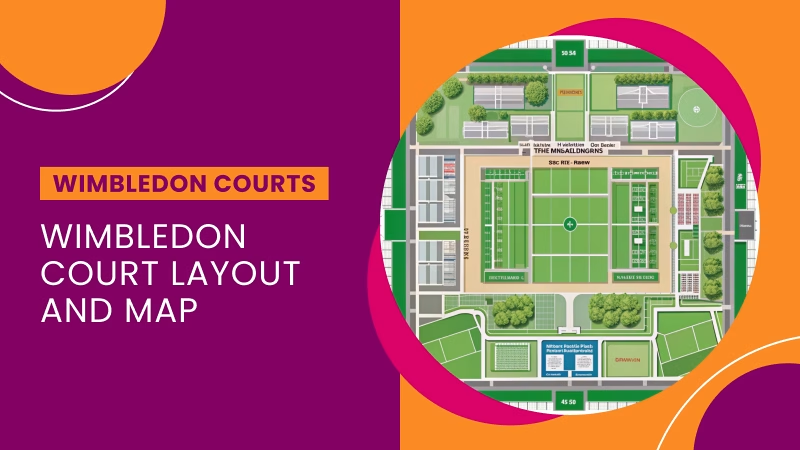
Wimbledon, of course, isn’t just the famous matches and grand tradition- it’s also a beautifully designed complex that brings sheer elation to tennis enthusiasts—
Situated on Church Road, London the grounds of All England Lawn Tennis and Croquet Club are so well-organized to enhance a player as well as the spectator’s experience. Most of us have never been to Roland Garros, but getting a decent orientation and knowing maps really well could make the difference from a good visit to this mythical tournament.
Grounds Interactive ground map
The entire Wimbledon grounds are a mix of old world charm and current day practicality that covers well over 100 acres with numerous courts, stadium, amenities and fan zones. An interactive map should hopefully guide all those attending the tournament. This tool is useful for identifying everything from that legendary Centre Court to the smaller outside courts such as Courts 3-18. A quick touch or click will take you to the Royal Box, the public ballot areas and even Henman Hill by name.
In the case of an interactive map, for example it will offer a birds eye view into what is at ground level with hot spots and real live court schedules as well as match results. Trying to get your bearings in the hustle and bustle of Wimbledon whether you’re looking for the nearest food stall, toilet or just trying to find where your favorite court is can be made easy with this interactive map. Opting for the more traditional method, printed maps are stationed at various points on site to lead you around.
Finding Your Way Through the System of Wimbledon
Getting around the Wimbledon site can feel intimidating, but it is spot-heated with well-signposted decisions and people on hand to direct you. The grounds are separated into the main courts, outer courts and fan zones.
Centre Court and No 1 Court are close together, centrally placed affording their best access from the main entrance. These are the main areas for scheduled encounters and they sit alongside other important places such as the Royal Box where dignitaries, VIPs (and Kim Sears ) enjoy watching their tennis. The farther you move away from the Berries, though, things begin to branch out; there’s Courts 2-18 where more matches are played and have a greater immediacy.
Henman Hill, or Aorangi Park sits just off of Centre Court and is a great place to spend with fellow fans watching the games unfold on massive screens in perfect sun-drenched chill. And with the layout of The Slamville supporting thoroughfare between courts and facilities, clear signage takes you where you want to go whether that means a quick bite or resting place near your games.
If you need a little guidance, there are information desks all over the show at Wimbledon. We offer actual staff at the terminal and can give directions, answer schedule questions or if you need anything during your visit let us know.
In a sport otherwise caricatured by its arid attachment to historical custom, Wimbledon shines like the rare diamond… with all of that pompous charm intact. With its status as the lone Grand Slam played ends on grass, Wimbledon ensures a unique factor when comparing with other major events like Australian Open, French Open and US Open that take place on hardcourts or clay court surface.
Central to the appeal of the tournament are its grass courts, including arguably most iconic tennis court in all sport in Centre Court. Centre Court, which features a retractable roof and has witnessed some of the player in Serena Williams demonstrate their prowess at Striptease Syndrome. Not only does this make the event beautiful to look at, but also offers a significant change for the competing tennis players being forced to play on grass. The ball stays flat bouncing closer to the ground, moving faster and leaving less room for hesitation or error from an athlete.
Everything about Wimbledon is neat — the entire entrance on Church Road has been planned to suit the needs of a tennis tournament. Courts 3-18: Outside courts serve a significant role in the event, providing fans an opportunity to watch exciting action and young talent. These courts, as uplifting and formative an experience it be to a player that just snatches the silver medal away from local rival you will never meet again – are only there for the real drama of tennis; All usually angry but fragile contrasts in personalities well up close and unexpected results dictate before your eyes on this perplexing canvas.
The International Tennis Federation in fact sanctions Wimbledon, not only because of its gripping history but also the tradition upheld and it’s unique conditions. By keeping the meticulously maintained grass courts in flawless condition and looking after them year-round, they’re able to host a world class tournament while managing playability all at once. A carefully organized and meticulously maintained grass court improves the durability to a large extent, while still ensuring that lawn tennis remains an appealing event in today’s game.
For the fans, Wimbledon is not just a Grand Slam; it’s an experience intrinsically woven in tradition. The Royal Box is beautiful, the buzz of Henman Hill and all those facilities across the grounds – it gives Wimbledon a great atmosphere. The club, formed as a private lawn tennis and croquet club, has maintained its tradition while meeting the demands of an ever-changing sport.
And as we consider the current edition with new developments that include retractable roofs placed on main courts, it shows how Wimbledon can have both a classic history and progress towards to 21st century. This evolution means that we are now in the fortunate position of having solutions to what used to be major challenges and it will help ensure people never miss a ball again, not least owing to our unpredictable English weather which simply does not impact upon matches any more with these high standards.
Wimbledon at its best is a celebration of tennis and tradition, intertwining to create an exquisite slice of the sport that only grass courts can provide. It retains its status as one of the great events on the tennis world calendar, with every match a testament to ability and desire of those playing — each visit an opportunity others would do anything for. One thing is certain, whether you are a long-time tennis fanatic or an up and coming believer that Wimbledon provides an intriguing experience as it forever wins over the hearts of fans across the globe.
Frequently Asked Questions (FAQ)

